Overview
In 1999, the American Society for the Prevention of Cruelty to Animals (ASPCA) had a static, print brochure-type Web site. Three years later, The ASPCA began using a custom-built content management system that fell short of the organization's needs because staff couldn't make content updates without the help of its Web design firm. So, this leading animal welfare group searched for a solution that would enable non-technical staff to maintain dynamic content on its Web site. Today, the organization maintains a 500-plus page Web site with dynamic, rich content. By selecting a suite of content management tools that non-technical staff can easily use, The ASPCA now is able to create an online experience that strengthens relationships with its constituents.
Problem
From 1996 to 2000, The ASPCA had a Web site that was effectively an online brochure with no interactivity or ability to accept donations. The organization originally created the site in-house and a Web site coordinator maintained it. In January 2000, the ASPCA hired a local New York City-based Web development agency to overhaul the site so it would be database-driven and easy for non-technical communications staff to update content themselves. (The revamped Web site was based upon a Microsoft platform using NT and a SQL database.) Unfortunately, this custom built solution was difficult for the communications staff to use and manage. Content updates were so tough to make that The ASPCA had to pay the Web firm by the hour to do the work. On top of that, the group wasn't always a "priority" client for the firm, which primarily served for-profit organizations. Another serious problem was that The ASPCA's new custom built tools for online donations were not complete the site could process gifts but staff had to handle all acknowledgements by hand which was a huge burden during surges in online giving.
Solution
In mid-2001, The ASPCA went in search of a new easy-to-use yet powerful content management system. The ASPCA then had more than 500 pages of content and needed a robust system. The organization was intrigued by the idea of "distributed content management" which would allow staff across the organization to update content. After interviewing and surveying vendors, The ASPCA selected ConvioTM as its solution and launched a new Web site in October 2001 (see fig. 1). The ASPCA also decided to replace its email marketing tool, a listserv called SparkLIST and retool online fundraising efforts using Convio.
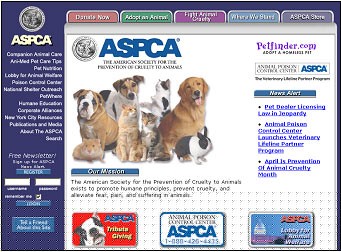
Fig 1 www.aspca.org
Content Management at The ASPCA Today
Today, The ASPCA is managing 1000-plus Web pages and able to make all Web site content changes in-house without having to pay an outside vendor. Non-technical staff in different departments can control content for their areas: the development/direct response team manages fundraising-related content and online campaigns; the advocacy/public affairs team manages advocacy-related campaigns and content; and the communications team manages the core of the Web site including the home page and a weekly email newsletter.
In the development department, one staff member is assigned primary responsibility for online marketing (e.g., emails, online campaigns) and Web content updates. It's a part-time role for this individual who also is responsible for managing the organization's donor database. The development team has full autonomy for its section of the Web site -- from small edits to creating new pages to publishing.
Now that The ASPCA can handle content management in-house -- quickly and with the workload shared across different functions, the organization is able to keep content fresh and react swiftly as developments warrant. Using a Web page building tool, administrators can easily create new Web pages and amend elements of existing pages. In addition, the organization is able to post news articles very quickly as "structured content", by filling out simple Web forms with information such as a subject headline, date and full story. These news articles are automatically filed into a news bank and appear in a "News Alert" section on The ASPCA's home page in headline format and in the news section ordered by theme. Consequently, The ASPCA can easily organize articles by topic area and show related stories.
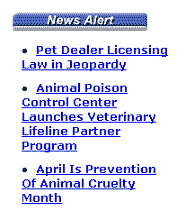
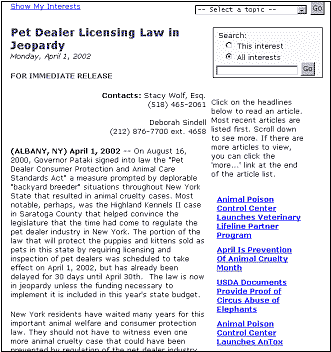
Fig. 2 ASPCA news headlines and article display
Another use of structured content by The ASPCA is the organization of photographic images into online photo albums (see fig. 3). As the Web editor inserts new photos, the albums on the Web site automatically update themselves.
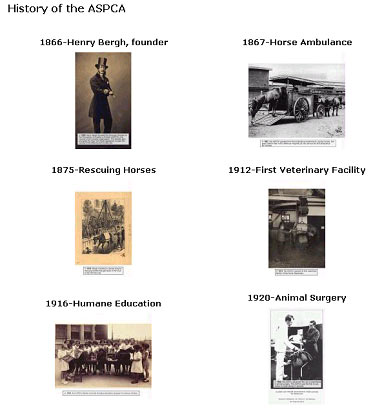
Fig. 3 ASPCA photo album example
Personalization is a Strong Component of Content Management
The ASPCA also uses personalization extensively. All site users are also encouraged to fill out a profiling form, which asks the supporter about his interests (see fig. 4). When the registered visitor returns, the Web site "recognizes" him, greeting him by name and displaying content tailored to his interests, e.g., a news story on a topic checked in his "interest" profile. The site also tracks and "remembers" the visitor's key online interactions and can adjust the content he sees on different pages accordingly. For example in the advocacy section of the site, a visitor who has not yet participated in a campaign is asked to participate (see fig. 5).
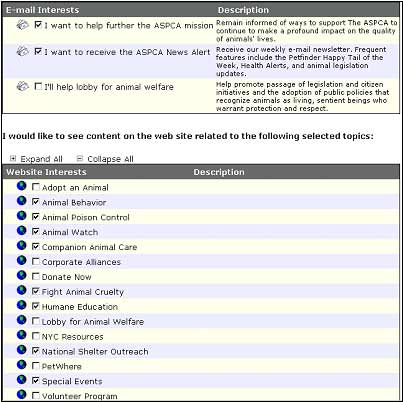
Fig. 4 Web content profiling form for personalization
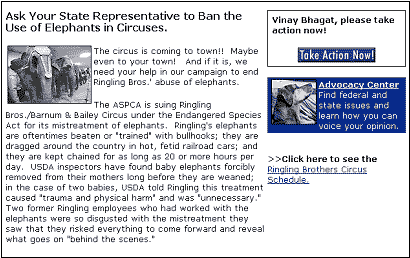
Fig. 5 Personalization can promote advocacy participation
The Web site's fundraising section displays specific messages for high value donors known as "Guardians." The ASPCA plans to set up a special, secure area of the Web site only for these major contributors, featuring additional news stories, the ability for them to submit personal stories and online recognition to promote loyalty.
The ASPCA also is able to learn more about people's interests by tracking their movement (or "clicks") on the Web site. The organization has set up special "profiling" links on its Web site that, when clicked, add an interest flag in the constituent's profile. For example, if someone clicks on the "adopt a pet" link, he will be put into a segment of people with an expressed interest in pet adoption.
Summary
With a powerful suite of content management tools, The ASPCA now is able to maintain a very dynamic Web site that always provides visitors with fresh, relevant information and that enables the group to build and maintain strong and personalized relationships with every constituent.








